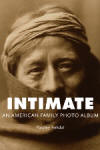Intimate
Paisley Rekdal’s artistic book Intimate may be, at first glance, part of an indefinable genre. Flipping through its pages, one finds snippets of poetry, family stories, photos, and biographies. As the subtitle indicates, this is a textual and visual photo album of American family history. In her book, Rekdal challenges the definition of “American” family by examining race, lineage, and gender through the fictional biographies of Edward Curtis (a photographer of American Indians) and his translator, Alexander Upshaw, as well as scenes from Rekdal’s own life and the lives of her white father and Chinese mother. These biographies are interspersed with Curtis’s photographs and Rekdal’s poetry. She urges us to take accountability—not only for our dysfunctional family histories, but for the bloodied and prejudiced histories that belong to the American identity. Rekdal’s language is both delicate, and sharp—like a thin slice of glass cutting through our histories, our masquerades, our deceits.
Paisley Rekdal’s artistic book Intimate may be, at first glance, part of an indefinable genre. Flipping through its pages, one finds snippets of poetry, family stories, photos, and biographies. As the subtitle indicates, this is a textual and visual photo album of American family history. In her book, Rekdal challenges the definition of “American” family by examining race, lineage, and gender through the fictional biographies of Edward Curtis (a photographer of American Indians) and his translator, Alexander Upshaw, as well as scenes from Rekdal’s own life and the lives of her white father and Chinese mother. These biographies are interspersed with Curtis’s photographs and Rekdal’s poetry. She urges us to take accountability—not only for our dysfunctional family histories, but for the bloodied and prejudiced histories that belong to the American identity. Rekdal’s language is both delicate, and sharp—like a thin slice of glass cutting through our histories, our masquerades, our deceits.
Each character’s story is written with a different font in order to visually represent the complexity and layers of America’s own history through its many voices. As Rekdal reminds us, we stem from our history. Her poetry accompanies Curtis’s photos, offering her own interpretation of Curtis’s intent of photographing American Indians, what her interpretation is of the physical work, and our interpretation of events being brought to these photos. Just as Upshaw translates for Curtis, Curtis translates his ideas of American Indian culture, and Rekdal translates for her readers. This is a book of translation—of events, of photos, of biographical facts. Even with her own family, Rekdal tries to interpret her parents’ courtship and her father’s feelings about her mother’s illness, reminding us that history is constantly shifting; it is not static.
Rekdal’s narrative style is akin to prose poetry—lyrical, brief bursts that create a lush and interwoven literary fabric. She invites us to think of her poetry and art as a response to history—how we make sense of the complex, violent, muddy history that is so much a part of the American identity. Rekdal’s words come alive much like how the gold-tinting technique that Curtis used on his photos seemed to bring the images to life. As Rekdal so precisely writes, photos turn “people into events, events into documents,” yet she questions the authenticity of these documents. In one example, she targets the inauthentic nature of Curtis’s photos. When he photographed Indians, he removed modern objects from their homes, so that they looked “authentic,” according to his stereotypes. The varying accounts of white and Indian killings, battles, and revenges are always slightly out of focus. Who takes the photo (or who writes the account) is just as important as the subject of that photo.
The beauty of the book’s form is that it so perfectly marries the content—fragments of writing about fragments of history. One of the most poignant accounts that Rekdal records (and I use that term loosely, as many details are fictionalized in the work) is the story of Curtis’s attempts to record the various Indian languages. His attempts are merely that, because there is never enough time or space to record all of the languages in one man’s lifetime. No record will ever be complete, only snapshots will be left. And in Rekdal’s story, we are reminded that all of us survive only in fragments. Whereas the standard biography attempts to capture all of the moments of a year or several years or a lifetime, and thereby define what is significant, Rekdal immediately signals to us that no story will ever be complete, and she will not even attempt to try and dupe us into thinking so. She writes in segments, because segments are all we have.
Even Rekdal’s racial identity is segmented. In one lovely passage, she questions her mother about her racial identity. Am I Chinese? she wants to know. “A part of you,” replies her mother, but Rekdal is left thinking, which part? Even her identity is broken into parts, not whole and not seamless. This segmented identity helps her to relate to the biracial Alexander Upshaw, who fails to be fully accepted by either American Indians or whites.
This book is also very much about the role of photography in history, and one will want to return to its pages to try and reinterpret photos and the texts they accompany. “To photograph [this place] so beautifully is to insist on a formalism nothing else in life can match or answer”—though I would argue that Rekdal’s own art gets very close. Rekdal reminds us that our lives are built from history—the history of our forefathers and mothers, the history of our enemies, and the history of our neighbors.





